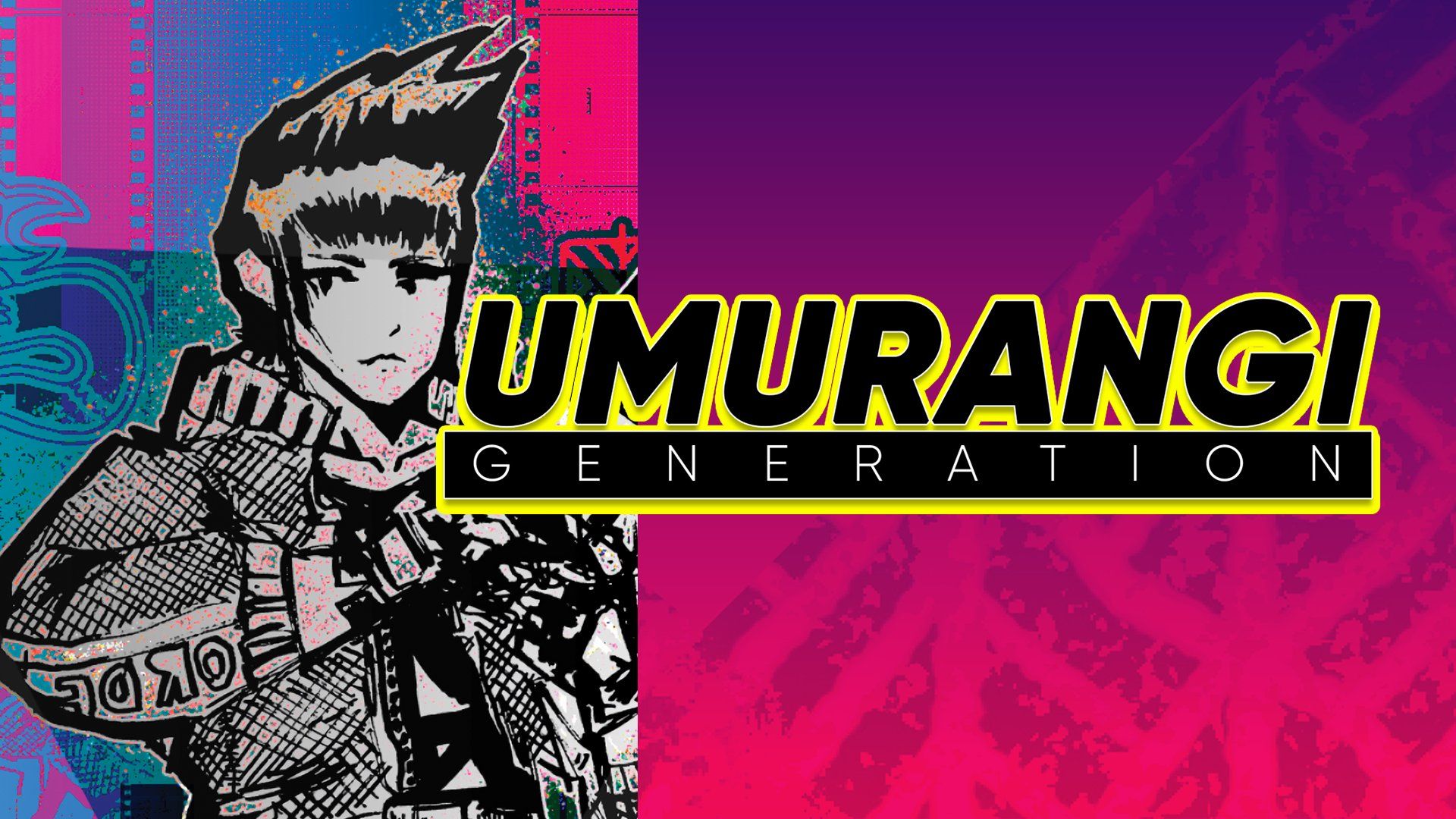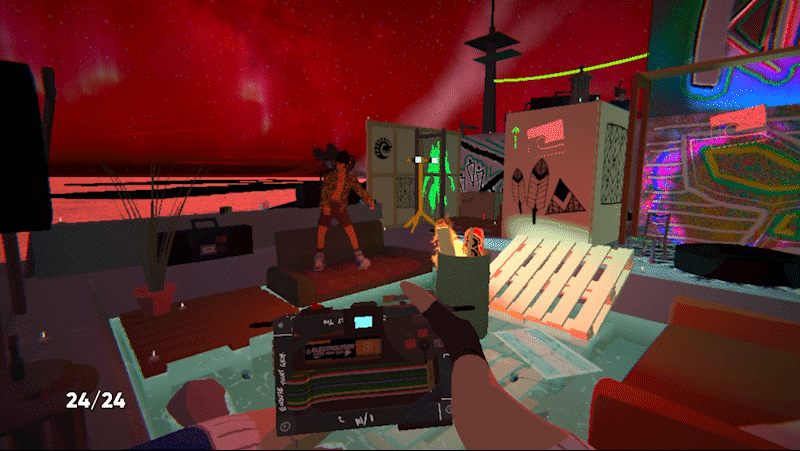Witnessing a Dying World in Umurangi Generation
What will you see at the end of the world?

In Umurangi Generation, the answer is aliens, raves, U.N. soldiers, giant robots, a penguin, and lots of graffiti. It is a photography game where players find the best angle and lens to capture the perfect shot and check off a list of required photos for each level. All of these levels are visually stunning, drawing on a minimalist cyberpunk aesthetic grounded in Māori culture and drawing inspiration from Jet Set Radio and its contemporaries. Beyond its visual appeal, the extraordinary environmental storytelling and worldbuilding woven through each level take Umurangi Generation from a dystopian edition of Pokémon Snap to a deeply memorable experience.
Games often invite players into an imagined world, expecting them to come and make choices, to interact with the characters and gameplay systems. The flow of interactions between the player and the world of the game produces stories and narratives that stay with us long after gameplay ends. Games such as Undertale and Dragon Age focus on the impact these choices have on the outcome of the story and the future of the world the player has entered. Other games, such as The Legend of Zelda: Breath of the Wild, use player decisions to contextualize and personalize an otherwise consistent experience, giving each of us a unique path to the same destination. And some games, like the Stanley Parable, revel in questioning whether a player’s choices can matter or even should matter. Ultimately, games are able to produce a variety of stories and narratives by responding to what the player decides to do within the game world.
Umurangi Generation asks what it means to be brought into a world and expected to do nothing but watch. It’s a speculative game set in a near-future of Aotearoa (commonly called New Zealand in English) that strips away the familiar trappings of player choice. Puzzles, enemies, and dialogue are all left out and the result is a world that the player can’t touch. It’s such an eerie experience that at times you start to wonder if you actually are a part of Umurangi Generation as a living character or just moving through the levels as a ghost.

This feeling comes to the fore as early as the second level, Otumoetai. The level opens with you facing a U.N. soldier and my first thought was “What happens if I photograph him? Will I get in trouble? Will he attack me or take my camera?”
It’s a familiar thought for anyone who has walked in public with a DSLR, especially when photographing a protest, conflict, or any scene where security forces are likely to appear. Even beyond these tense environments, people react to cameras. They ask you not to take their picture, some get angry if they think you did, others start posing or quickly move away, many unconsciously start grooming — fixing a piece of hair, straightening an article of clothing — Umurangi Generation leaves all of these subtleties out as NPCs, including that U.N. soldier, have no reaction to your looking and photographing. It’s a break with realism that produces a powerful effect.
First, it’s freeing. Walking through crowded train cars, city streets, and war zones without getting yelled at “Hey! Don’t take a picture of me!” or having your camera knocked to the ground is actually really nice.
Second, it’s a clear reminder of what the game is about — and it’s not about being a photographer. Umurangi Generation isn’t interested in exploring the challenges of photographing dystopia; it is concerned with what it means to watch the onset of dystopia while being powerless to stop it and photography serves as an apt tool and metaphor for exploring that experience.
“I chose Umurangi Generation, you know, Red Sky Generation, because the idea was to talk about how our generation is coming of age at the moment having to deal with older generations destroying the earth in-front of us. And we can’t really do anything about it. We can go and protest, sure, but in terms of being the people who actually push the buttons, we’re limited in that space.”
Veselekov, creator of Umurangi Generation, in an interview with Vista Magazine
While most of the game is spent looking at an unalterable world and taking pictures of it, there are a few moments in Umurangi Generation that afford players interactions beyond observation. One of my favorites is changing your friend’s poses. In each level, you are accompanied by Micah, Atarau, Kete, and Pengi who can usually be found vibing out somewhere in the environment. You can walk up to each friend and change their pose to set up an impromptu photoshoot. It’s noticeable that this interaction is not afforded to any of the other NPC characters. I found this to be a thoughtful reflection of the ways in which real world Umurangi Generations often act locally in small, intimate chosen communities.

Another moment where more interaction becomes possible is towards the end of the Macro DLC. The game brings you to the scene of a protest and all around you are walls covered in graffiti — a common sight throughout the game but never to this extent. The messages are about resistance, anger, defiance, futility, and desperation. Completing this final level requires the player to add their own message to the collection of graffiti, finally going beyond observation to making a mark on the world.
It’s a climactic moment that is made complex when we consider the role photographs and graffiti play in Umurangi Generation and our own world. Graffiti, treated often as a blemish to be removed and not a “true” art form, is one of the only ways for its artists to communicate and publicly memorialize their experiences in an environment which would rather see them silent. This is true across Umurangi Generation and the real world and the game pulls on that context to give a sense of importance to what you add to its virtual walls.

We use photographs to both record history and provoke change. Our collective instinct has been to pull out a camera not only when we see something we like and want to hold on to, but also when we see something we don’t like. Cameras often become tools to show the world that an awful thing is happening. This instinct reveals our sense that a photograph, better than a description, will bring the issue to light in a way that will force change.
Which raises the question, who in Umurangi Generation is meant to see these photographs? Who was our graffiti message for? In a world already undergoing multiple collapses, what change is any of this meant to provoke?
The photos are for us, not as the character within the game but as people outside the confines of the game. They are mementos from a dystopic future, warning us in the present. The game tells us this most clearly every time we stop playing by asking us to share in-game photos on Twitter, ensuring that the warnings from this future don’t go unheard. Umurangi Generation also trains us as photographers. This goes beyond the technicalities of lenses and camera settings (which are included) but also how to think about photography. During each level your photos receive a monetary value, usually of a few dollars; in the final DLC level the monetary value of each photo skyrockets, reflecting the importance of frontline reporting on resistance movements. The final DLC level also penalizes you for photographing protestors’ faces, reminding us of the importance of preserving anonymity to prevent persecution.

Like the photos, the graffiti is also meant to provoke change in us, acting as a moment that forces the player to participate in protest and resistance. Spray painting a government building is something deeply uncomfortable, if not unthinkable, for many of us to do outside the game world. Umurangi Generation lets us practice, presenting it as a cathartic act after the tension building up through each level.
With Umurangi Generation, Veselekov has given us not only a vision of the future, but a way for us to think about how a community, or even an entire generation, can experience the idea of the future as something lost and beyond our reach. Each level of Umurangi Generation is tinged with the despair arising out of that experience. But Veselekov doesn’t stop there, acknowledging the hopelessness that stems from being relegated to the position of an observer, the game also pushes back by turning its single-player experience into a social device by encouraging players to share and experience the photos as a community.
What we see in the photos of the world of Umurangi Generation is a warning and glimpse into what our world might look like if we continue along the path we are going. The game doesn’t try to teach us how to prepare or survive the future it depicts, it calls on us to prevent that future from ever occurring. Umurangi Generation itself acts as a photo of the future, something meant to be so jarring and undeniable that it jolts us into action. Umurangi Generation wants us to do more than watch and bear witness.
Umurangi Generation ends with a lament and a love note, dedicating itself not to the dying world, but to the generation left with nothing to do but watch it perish.